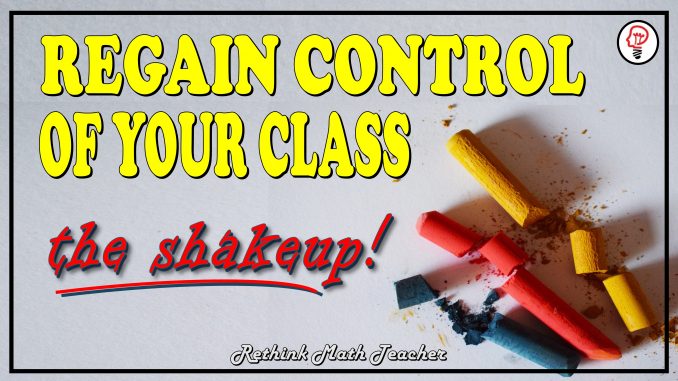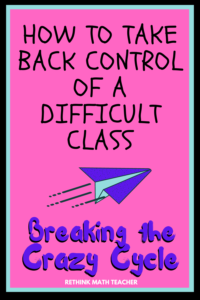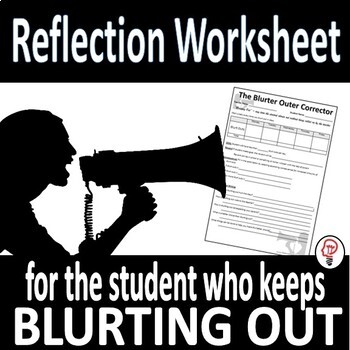
Have you ever gotten caught in “the crazy cycle” with your students, their behavior, and your classroom management? It’s a terrible place to be. It’s no fun, and everyone looses.
Here’s what it looks like:
Your class is misbehaving, so you ratchet up your discipline. They respond with indignation. You don’t see the change you expect, so you increase your toughness. You yell a lot. You’re super strict, and they hate you for it. Your students respond by behaving worse.
As your strictness increases, and your consequences rain down, their misbheavior increases and their defiance becomes overt.
This is a loosing battle. The students loose, because they aren’t learning and they’re constantly facing your wrath. But you loose too. You loose your joy, your sanity, and your effectiveness.
I know many teachers who’ve been caught here. It’s a tough place to be, and an even tougher place to get out of.
The crazy cycle extends beyond the classroom, as the students go on the offensive at home. The propoganda machine starts it’s job as a smear campaign ensues. Parents hear horror stories from their students that are reinforced by their childrens’ friends, who are in that class, as well as the parents of their child’s classmates.
Emails and phone calls start to take their toll. They increase in nature and ferocity. The parents begin an offensive, lodging their complaints to the teacher and administrator.
Meanwhile, the students lose fear of the consequences that the teacher can levy. They know that their parents will not support the disciplinary measures the teacher tries to handout, since they have bought into the stories they’ve been hearing about the teacher. So the students become emboldened to increase their misbehavior.
I’ve seen the crazy cycle many times.
I witnessed one teacher who tried to combat the crazy cycle with a plethora of detentions. Her students began ripping them up in her class. Another teacher sat helplessly as a room full of students began screaming at the top of their lungs. I witnessed one teacher completely check out. He put a movie on his laptop, his headphones on, and sat in the back of the room leaving his students to their own devices.
No one wins in the crazy cycle.
How to Break the Crazy Cycle
You can’t win this fight. As you increase your consequences, and discipline, your students will increase their resentment and hostility. You may get them to stop talking, but you will not get them to learn. It’s hard to learn from someone you despise.
Instead of continuing the crazy cycle, and increasing your consequences by disciplining the whole class, I recommend you break the cycle.
Before moving forward I’d like to stress that we are not excusing bad behavior or disrespect, nor are we lowering our expectations. But we’re also no longer punishing the whole class, nor are we turning into a frustrated, yelling, drill Sargent who’s waiting for a student to make a small mistake so that we may unleash our wrath.
Instead, we’re going to address the issue with the class, commit to ending the war, and find our joy once again.
Step 1 – The Shakeup
If you’re caught in the crazy cycle, then your students are coming into your class with certain expectations. They might be coming into class prepared for an awful experience and dreading it. Or they might be coming in committed to doing everything they can to make your life miserable.
So begin class by breaking their normal routine to catch them off guard.
One teacher took over a class and didn’t like the seating arrangement. All the chairs were not facing the front of the room which led to off task behavior at the beginning of class. So he switched all the chairs, placing them in rows, all facing the front. When the students entered, they were all confused. They tried to return the chairs but he demanded that they did not. Everyone sat down, and he had their full attention.
Another teacher was having an issue with students misbehaving when they went to out their backpacks on the table in the back of the room, where they were supposed to be stored on top of. So he removed that table from the class.
I once had a group of students who would sit at the same table for breakfast every morning in the cafeteria. They’d misbehave and we’re constantly late to class. So I started assigning them knew seats. But there were so many of them, it was difficult to keep up with. Plus, if I had to go somewhere else on campus, they all wondered back over to their favorite table and the problem persisted. So I folded up the table and rolled it out of the cafeteria every morning for a few weeks.
Change the daily routine to throw them off and get their attention.
To learn more about “The Shakeup,” read this article:

Step 2 – Address the Issues
Your students might not be mature enough, or aware, of what’s happening in the classroom and how they are contributing to the issue. But they do know that they are not behaving as they should. That said, if you were to ask them why this was occurring, they would say, “It’s because the teacher is doing such and such.”
So now that you’ve implemented ‘The Shakeup,’ you now have your students’ attention. Now, you’re going to address the issue so that you and your class can walk away from it. Call it a cease fire.
Begin with an Apology
You’ve been frustrated with your students, less then pleasant, and probably a bit overbearing. Not that it’s without a cause, or even unjustified. But your students have not enjoyed you. So tell them so.
Mine would look like this. “I want to begin by apologizing to you guys. I know I’ve been less than pleasant, and I’m sure you guys haven’t been enjoying me or this class lately. So I’m going to commit to being more pleasant, and trying to be more enjoyable. But I need your help…”
Do not blame your students or turn your apology into a condemnation of their behavior. Simply let your students know that you recognize that you haven’t been pleasant… and move on.
Step 3 – Build a Partnership
Remind your class that you all are in this together. This is our classroom, our class, our time together – and their education.
Continuing, I would say, “So we want a clean, organized, and safe room. We’re all going to be in here for an hour (or longer), and no one wants to be in a messy room or an unsafe environment.
“We want an enjoyable class, where we learn, but also smile and have good experiences. We want to be smarter, so we can have a great future, but we also want a good ‘today.’
“But we can’t have a positive, enjoyable, and educational time in a safe, tidy room if we don’t work together. Which is why I need your help.”
I would gently remind students that they haven’t been helping you accomplish these goals. They’ve been shouting, messing up the room, disrespecting each other, etc. You don’t have to spend too much time reminding them of their flaws, nor do you need to be specific – they know what’s been going on. But remind your students that their behavior has not helped you with your goals or them with their goals.
Then ask the students for their support.
You’re committing to trying to be more pleasant and forgiving, they need to commit to following class rules, being more respectful, and trying harder on their responsibilities (like doing their work).
Step 4 – Move on with the Right Tone
After apologizing, asking students to help you, and committing to each other to do better, tell the class that we’re going to do one academic thing for ten minutes, while you take role and do whatever else you need to accomplish, and then, in keeping with your commitment you’re going to do something a bit more enjoyable.
For your enjoyable element, it doesn’t have to be anything huge – like going outside to play kickball or watching a movie. Plan a short, fun thing to do together. A simple game, a short video, a hands on activity, etc.
Remember this is a class that hasn’t been behaving well, so you don’t want to give them too much latitude or they will quickly revert to their old ways and chaos will ensue. But you do want to take a step towards fostering a more positive learning environment (which was part of the deal you just made with your class). So plan a small, simple, activity to do, that has little opportunity for them to get into trouble, but has lots of opportunity for them to have fun; and for them to see you in a positive light.
After they have done the first academic piece that you asked them to do, and you’ve gone over it, thank them for working so hard and then set the expectations for the next activity. (Remember, students respond well to positive reinforcement. BE SURE TO THANK THEM!)
Next, explain that you’re going to do whatever it is you’ve planned that’s enjoyable and simple, and then remind everyone of the expectations while it’s happening. Also remind them that after you do this thing, you are going to do some more academic things to help them learn and get a good grade.
Step 5 – Give them a Good Grade
I know STEP 5 will get me negative comments and nasty remarks when this is shared on social media. But I refuse to take it out. It is such an effective tool in helping break the crazy cycle. So please don’t skip this.
You have done several activities with your students today. Give them a participation grade for it.
You could go one step further, and as part of your ‘talk,’ you and the class can select a behavior to work on, “Like raising their hand before speaking.” As part of the practice, set a goal of earning so many points in class for practicing this skill correctly. Keep tallies on the board throughout the period, and let them earn some type of positive reinforcement (or extra credit) for meeting this goal.
If you are struggling with the idea of a completion grade, you are missing how dire the situation is.
When I have worked with some teachers caught in the crazy cycle, some have objected to the idea of giving their students a good grade for the day. “They have been misbehaving, they haven’t earned it!” “This type of grading diminishes the other grades.” “What message are we sending about grades, if they can get an A just for participating.”
These teachers have totally missed everything and will not escape the crazy cycle. And I cannot emphasize this enough.
The crazy cycle swallows teachers up. It is nothing but pain for eveyone involved, espeically the educator. I have been caught in the crazy cycle, I did not espcape it. That’s why I committed to helping other teachers find success. You can read about that incident, and more on classroom management, in my book: Taking Control of Your Classroom Management.”
There’s nothing wrong with a participation grade. There’s nothing wrong with extra credit. It’s not lowering your standards. It’s calling a cease fire on the crazy cycle battle you are facing, and sending a signal to your students that you’re not mean and inflexible, you want to work with them so that we can all be successful.
Please don’t skip this step.
If you’re giving an appropriate ammount of grades, this one will not make a huge impact on everyone’s overall average. It will, however, make a huge impact on your classroom management.
Step 6 – Send Positive and Informative Emails Home
Consider, for a moment, being in the parents’ shoes for the following situation:
Your child, whom you love, (let’s pretend its your daughter) comes home and you ask her how school went. She tells you a few things, and then complains about Teacher So-and-So (in this scenerio, Teacher So-and-So is the teacher about to get caught in the crazy cycle). You, the supportive, rationale, parent, let her know that you’re confident that Teacher So-and-So is not as bad as the she says, but she assures you that the teacher really is that bad. In fact, So-and-So is mean, talks down to the students, and hands out detentions for no reason!
You, the parent, again dismiss your daughter’s complaints, but you don’t forget them.
A few days later, your daughter again tells you a horror story about Teacher So-and-So. You find it hard to believe, but you also don’t believe your child to be a liar or to make things up without reason. “There is a little bit of truth behind every lie,” you remind yourself.
Your parental concerns start to kick in. The child that you love seems to be suffering, placed in an unbearable situation. But again, you find it hard ot believe that Teacher So-and-So is really this bad. So you text your friend, whose son, Billy, is also in your daughter’s class, “Have you heard anything about what’s happening in Teacher So-and-So’s class?” The parent responds, “Billy says Teacher So-and-So is mean. He doesn’t like Teacher So-and-So. Says she constantly yells at the class and belittles the students.”
A few days later, one of your daughter’s friends is at the house, who also confirms the story: Teacher So-and-So is not a good teacher, and gives out tons of detentions for no reason.
A few more days pass when you, the parent, get an email from Teacher So-and-So letting you know that your daughter has been misbehaving in class. It reads, “Talking out and being disrespectful towards the teacher.” That’s all the email says about the event (no other specifics). Your daughter has never been in trouble before, and you start to get suspicious. When your daughter gets home, you grill her.
“What happened that I’m getting a note from Teacher So-and-So?”
“Mom, (or Dad),” she rebuttles, “You would not believe what happened! The other students were talking out while Teacher So-and-So was trying to teach. So I asked everyone to be quite, and Teacher So-and-So yelled at me! I told you, Teacher So-and-So is mean, and gives detentions for no reason.”
That’s ridiculous, you think. No teacher in their right mind would ever do that. But you have no other information from Teacher So-and-So about the event to combat this narrative. You text Billy’s dad to see if Billy know’s anything. Billy tells a similar tale, your daughter didn’t do anything wrong and Teacher So-and-So was mean for no reason.
How do you feel about Teacher So-and-So? What do you believe?
More importantly, what information have you (the parent) received to help you see any side besides that of your child’s?
Communication is your Best Counter Offensive
Consider, on the other hand, if you had been recieving regular, consistant, and positive communication from Teacher So-and-So. You would have a much better impression of the teacher prior to your child’s remarks. You’d be more likely to see both sides.
I try to send positive emails home to parents, with specific information about their student early in the year. It’s difficult for a student to complain about me when I’ve already given them some brownie points in their parents eyes. And if they do, I can only imagine the parent responding, “You think he’s not nice, after he said those wonderful things about you?”
I also try to send weekly (if not more often) emails about what’s going on in class. I include information about what we’re learning, some resources for extra support or practice, and reminders about upcoming assignments. This constant communication not only helps students with their academics, but it also buys me a lot of good will in the eyes of the parents, who appreciate this communication. It also helps strengthen the relationship between me and my students, which improves classroom management.
If you make parent commuincation part of your regular habit, you are less likely to fall victim to the crazy cycle.
If you are in the crazy cycle, it’s not too late.
Start sending sending positive, informative emails home.
I would send one the day after you implemented steps 1 through 5 above. It would look something like this:
Greetings parents,
We had a great day in (name of class) today! We did (name of learning activity) and the students enjoyed it a great deal. We also worked on (name of assignment done in class). If your student did not finish it in class, please remind them it’s due tomorrow. If your student need help with the work, this website is a great resource (link to website with tutorial video or explination of the work – or link to your teaching video from when we were doing distance learning).
Also, we are working on getting better at raising our hand before asking questions in class. If you could help reinforce this at home, I would appreciate it. But our class did really good with this habit today and earned an extra ticket (or whatever positive reinforcement you choose).
Sincerely,
Teacher So-and-So
Step 7 – Press On

The goal of this excercise is to get back to a well run classroom. You’ve made some concessions, and done things you would not have normally done. But your goal is to get back to a good learning environment that is positive and educational.
Do not convert to an ineffective classroom that is all fun and games.
I counseled one teacher caught in the crazy cycle, who decided that she would bribe her students by giving them the back half of each class to have free time outside. So the students would come and work for 20 minutes, and then go outside and play while she read a book.
For starters, she wasn’t building a relationship with them, she was just bribing them. And obvisouly, more than that, she wasn’t educating them. Beyond that, her classroom management system now fell down to payment for good behavior, which is not effective, and will not work on a consistant basis.
You are not shifting to a bribery system where good behavior is rewarded with things you would not otherwise do (like cancelling class to play basketball without administrator’s approval). This is not effective. Students need to behave correctly because that’s the expectations, and you need to get back to this place. However, it will take some time. But move towards that direction. Do NOT abandon the idea of educating your students the way you know is best for them.
At the same time, you are working on building relationships. So you should have some things that help restore the relationship. Show a two minute funny video, share a story, do a fun learning activity, or do something else that will help your relationship grow.
How to Take Control
If you want to go deeper, with more step-by-step instructions on how to have an effective classroom management system in place, please check out my book; Taking Control of Your Classroom Management.






